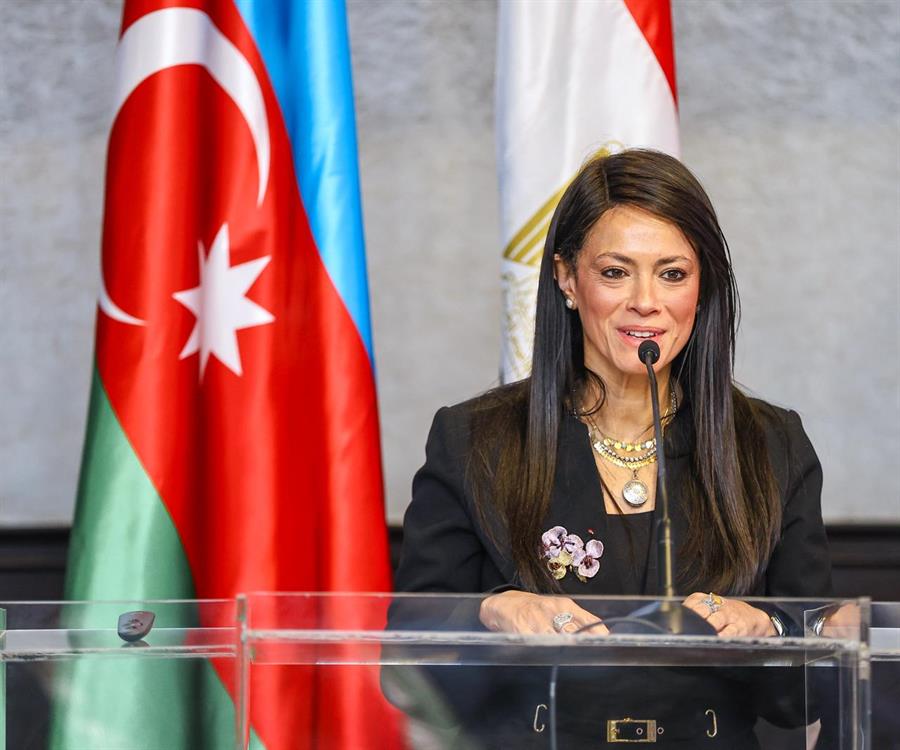For the first time in more than three years, Egypt’s quarterly Gross Domestic Product growth exceeded 5% in the first quarter of FY2025/2026, reaching 5.3%

27 November 2025
The Ministry of Planning, Economic Development, and
International Cooperation announced that Egypt's growth momentum continued to
strengthen in the first quarter of FY 2025/2026, with Gross Domestic Product
(GDP) expanding by 5.3 percent, up from 3.5 percent a year earlier and marking
the strongest quarterly performance in over two years. This acceleration
reflects the tangible impact of ongoing economic and structural reforms that
are bolstering the real economy, crowding in private-sector activity, and
steering the growth model toward tradable, high-productivity sectors such as
manufacturing, tourism, and telecommunications.
On the expenditure side, investment contributed a positive
2.45 percentage points to growth, reflecting the notable improvement in capital
formation. This development signals a recovery in investor confidence and
highlights the growing role of private investments in supporting Egypt’s
economic expansion.
This development is further reinforced by the clear
structural shift in favor of the private sector; private investments grew by
25.9%, accounting for about 66% of total executed investments, the highest
level recorded compared with previous periods. In contrast, the share of public
investment declined to 34%. This pattern reflects the government's approach
toward rationalizing public investment spending and prioritizing high-impact
projects, while simultaneously strengthening the role of the private sector as
a key driver of investment activity and economic growth.
GDP growth indicators also confirm the continued improvement
in economic activity in Egypt during the first quarter of the current fiscal
year, with the non-oil manufacturing index rising, driven by growth in the
motor vehicle industry of around 50%. The chemical products industry achieved a
growth rate of nearly 44%, as did the beverage industry at around 37%, the
furniture industry at around 34%, the pharmaceuticals and medicinal chemicals
industry at a growth rate of 19%, and the ready-made garments industry at
around 17%.
The growth achieved in the manufacturing sector reflects an
improvement in domestic and foreign demand, an expansion in production
capacity, and an improvement in the industrial business environment, especially
in light of the ongoing structural reforms. This is largely evident in the
sector’s actual performance, driven by a genuine rise in production levels
rather than by price fluctuations.
Preliminary economic indicators point to a positive outlook
for GDP growth in FY2025/2026, with projections placing growth at no less than
5 percent and upside risks tilted toward even stronger performance. This
outlook is supported by improving macroeconomic stability and the continued
implementation of economic and structural reforms aimed at strengthening the
real economy and expanding productive capacity, where “macroeconomic stability
enables structural reforms, while reforms reinforce stability, laying the
foundation for sustainable growth.” Moreover, a more stable regional
environment, bolstered by the efforts of the political leadership, is expected
to further enhance confidence and support economic activity in the period
ahead.
Key Highlights:
The growth rate achieved during the first quarter of fiscal year 25/2026 was driven by expansion in a number of high-productivity sectors, including non-oil manufacturing (14.5%), communications and information technology (14.5%), tourism (13.8%), and financial intermediation (10.2%). Other sectors also experienced notable growth, including insurance, electricity, social services (including health and education), wholesale and retail trade, and agriculture.
The growing performance of non-oil manufacturing activity during the first quarter of 25/2026 was driven by strong performance in several industries, which were able to convert production expansion into actual exports, resulting in activity growth of 14.5% during the quarter.
Suez Canal activity also recorded positive growth of around 8.6% for the first time since the second quarter of fiscal year 23/2024, as activity continued to achieve negative growth rates for a period of nearly a year and a half as a result of geopolitical tensions in the Red Sea region, which negatively affected the number of ships passing through the canal.
On the other hand, extraction activity continued to decline during the first quarter of 25/2026, contracting by 5.3% during the quarter as a result of a 6.6% decline in petroleum activity. While natural gas activity contracted by 10.9%. However, the pace of contraction began to slow compared to the corresponding quarter of the previous fiscal year, when the extraction sector contracted by 8.9%, in the context of recent gas field discoveries and exploratory well drilling.
On the expenditure side, the analysis of the first quarter of FY 25/2026 shows an improvement in investment, which contributed approximately 2.45 percentage points to overall growth, driven particularly by private investments, which increased by 25.9% and accounted for the largest share of total executed investments (66%).
ــــــــــــــــــــــــــــــــــــــــــــــــــــــــــــــــــــــــــــــــــــــــــــــــــــــــــــــــــــــــــــــــــــــــــــــــــــــــــــــــــــــــــــــــــــــــــــــــــــــــ
The Ministry of Planning, Economic Development, and
International Cooperation announced that Egypt's GDP growth rate rose during
the first quarter of fiscal year 2025/2026, reaching 5.3% compared to the
growth rate achieved during the first quarter of fiscal year 24/2025, which was
around 3.5%. This acceleration reflects the tangible impact of ongoing economic
and structural reforms that are bolstering the real economy, crowding in
private-sector activity, and steering the growth model toward tradable,
high-productivity sectors such as manufacturing, tourism, and
telecommunications.
Dr. Rania Al-Mashat, Minister of Planning, Economic
Development, and International Cooperation, noted that the higher-than-expected
growth rate recorded during the first quarter of FY2025/2026 reflects the
sustained and consistent strengthening of Egypt’s growth momentum, driven by
the strong performance of non-oil manufacturing, tourism, and
telecommunications. This reflects an economic model focused on tradable and
higher-productivity sectors, capitalizing on Egypt’s robust infrastructure that
provides a supportive foundation for manufacturing and investment, as detailed
in “Egypt’s Narrative for Economic Development: Reforms for Growth, Jobs and
Resilience”.
The Minister also highlighted that preliminary economic
indicators point to a positive outlook for growth in FY2025/2026, with initial
forecasts to reach at least 5 percent and promising upside potential. This
outlook is underpinned by macroeconomic stability and the continued
implementation of economic and structural reforms that strengthen the real
economy and enable greater private-sector participation.
The growth witnessed in the first quarter of fiscal year
25/2026 was reflected in the continued recovery of non-oil manufacturing
activity, achieving a growth rate of 14.5% during the quarter compared to the
same period of the previous fiscal year, during which activity recorded a
growth rate of about 7.1%.
This remarkable growth coincides with current efforts to
localize a number of industries, particularly high-tech industries, and expand
existing industries. Preliminary estimates indicate that mobile phone
production in Egypt will reach more than 10 million devices in 2025, compared
to only about 3.3 million devices last year. Industrial production, as
represented by the non-oil manufacturing index, also increased, driven by
growth in the motor vehicle industry of about 50%, the chemical products
industry with a growth rate of nearly 44%, as well as the beverage industry by
about 37%, the furniture industry by about 34%, the pharmaceuticals and
medicinal chemicals industry by 19%, and the ready-made garments industry by
about 17%.
The expanding performance of non-oil manufacturing activity
during the first quarter was driven by the strong results recorded in several
export-oriented industries. Semi-finished exports grew by approximately 34.1%
in August 2025, while fully finished exports also recorded a growth rate of
nearly 2.4% during the same month. Notably, ready-made garments, one of the
most significant fully finished categories, experienced a strong growth rate of
about 20.6%. This performance reflects the sector’s ability to transform
production expansion into direct export growth, benefiting from the flexibility
of domestic supply chains and stable demand in Gulf and European markets.
In addition, Suez Canal achieved positive growth for the
first time since the second quarter of fiscal year 23/2024, of approximately
8.6%, with the gradual return of stability to the Red Sea region, which
contributed to restoring the confidence of global shipping companies and their
renewed reliance on the Suez Canal as a main route. It is worth noting that the
Suez Canal had experienced negative growth rates for a period of nearly a year
and a half as a result of geopolitical tensions that negatively affected the
number of ships passing through the canal.
The communications and information technology activity
achieved remarkable growth during the first quarter of fiscal year 25/2026,
reaching 14.5%, driven by the state's strategy to transform it from a service
sector to a technology-based productive sector focused on outsourcing, in
addition to its role in promoting Egyptian digital exports.
Several economic sectors also continued to achieve positive
growth rates during the first quarter, with tourism activity recording a growth
rate of 13.8% as a result of continued support, improved quality of services
and tourism infrastructure, and campaigns to promote Egyptian tourism, which
succeeded in attracting nearly 5.1 million tourists during the quarter. This is
in addition to the digital transformation and artificial intelligence
technologies that the Ministry of Tourism and Antiquities is employing to
enhance the tourist experience for visitors and attract a wider range of
visitors through innovative marketing campaigns.
These efforts to boost growth in the tourism sector have
been reflected in Egypt's improved ranking in international indices, as Egypt
continued to top the list of leading tourist destinations in Africa for the
third consecutive year, according to the Nation Brand Performance ranking for
24/2025 issued by the World Economic Forum's consulting firm, Bloom. In the
same context, Egypt jumped six places internationally to become one of the top
25 countries in the international ranking in terms of tourism performance,
reflecting Egypt's success in overcoming the effects of geopolitical tensions
and the return of Egyptian tourism to the global scene.
The tourism sector is expected to continue flourishing over
the coming quarters, particularly following the opening of the Grand Egyptian
Museum, which is projected to attract around 5 million visitors annually. This
is likely to lead to a substantial increase in both visitor arrivals and
tourist nights.
Financial intermediation, electricity, social services
(including health and education), and construction also achieved positive and
high growth rates of 10.2%, 5.4%, 4.6%, and 3.3%, respectively. This reflects
the diversity of sources of growth in the Egyptian economy, in line with the
state's vision to diversify the economic structure and boost development rates
in all sectors.
On the other hand, the output of the extraction sector
declined by 5.3% during the first quarter of fiscal year 25/2026 as a result of
the contraction in oil and natural gas activities during the quarter by 6.6%
and 10.9%, respectively. Nevertheless, the pace of contraction in the
extractive sector has begun to slow compared to the rate of contraction
recorded in the first quarter of fiscal year 24/2025, which stood at 8.85%.
This improvement is due to recent discoveries of gas fields
and exploratory wells, with nearly 75 new oil and gas discoveries since August,
and 383 new wells added to the production map. These discoveries have
contributed to adding approximately 1.1 billion cubic feet of gas and
approximately 200,000 barrels of crude oil per day to production capacity,
saving approximately $6.7 billion in petroleum and gas imports, and reducing
the gap between production and consumption.
On the expenditure side, Investment recorded a positive
contribution of 2.45 percentage points to growth, signaling the beginning of a
recovery in capital formation and a strengthening of investment activity.
Although net exports contribution remained negative at -1.78 percentage points,
it represents a notable improvement from the -3.25 percentage points recorded
in the corresponding quarter of the previous fiscal year, indicating a gradual
rebalancing in external sector dynamics.
The first quarter of FY 25/2026 reveals a clear shift in the
structure of investment within the Egyptian economy. Private investment
recorded strong growth of 25.9% compared to the same period of the previous
year, accounting for approximately 66% of total executed investments. This
trend highlights the rising role of the private sector in driving investment
activity, alongside the government's pursuit of a more disciplined approach to public
investment spending. This was reflected in more moderate growth in public
investment and a decline in its share to around 34% of total investments. This
structural shift emphasizes the success of efforts aimed at improving resource
allocation efficiency by rationalizing public investment and focusing on
priority projects, while creating a more conducive environment that enables the
private sector to undertake a larger role in leading economic growth.
External trade data for the first quarter of FY 25/2026 show
a relative improvement in certain export categories. Exports of goods and
services grew by 1.3%, while imports of goods and services increased at a
faster pace of approximately 9.4%. The structure of merchandise exports during
the quarter exhibits a notable degree of diversification, whereas intermediate
goods constitute the largest component of the import structure.
Preliminary economic indicators point to a favorable outlook
for GDP growth in FY2025/2026, with projections suggesting that the economy
will achieve a growth rate of no less than 5 percent, supported by upside
factors that could lift growth even further. This outlook is underpinned by
sustained macroeconomic stability and the continued implementation of economic
and structural reforms aimed at strengthening the real economy and expanding
productive capacity. Moreover, the relatively calmer and more stable regional
environment, supported by the efforts of the political leadership, is expected
to bolster confidence and improve economic prospects in the period ahead.









